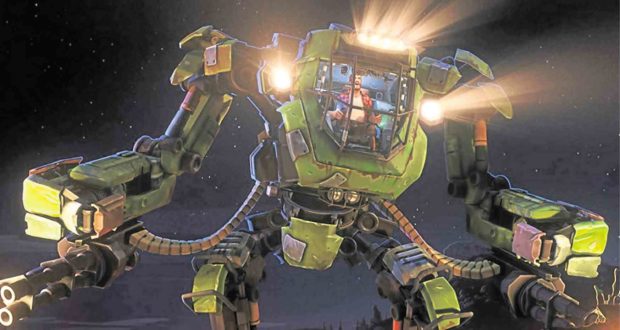Flashy worlds electrify ‘Love, Death & Robots’
Imaginative and often visually brilliant, “Love, Death & Robots” is an animated anthology series for adults currently streaming on Netflix.
The 18-episode show, created by Tim Miller (“Deadpool”), is composed of horror, fantasy, science fiction and comedy stories, told in portions ranging from six to 17 minutes. It’s an eye-popping, eclectic mix of shorts that are mostly meticulously done. While not every story is mind-blowing or original, there are certain standouts in an already sublime collection:
“Suits,” directed by Frank Balson, centers on a group of farmers piloting mech-suits to prevent their cattle from being decimated by swarms of hungry and savage extraterrestrial “bugs.”
Gorgeously rendered to appear like two-dimensional classic cartoons, but still digitally executed (seen mainly in the incredibly detailed designs of the robot “tanks”), “Suits” is a fast-paced, if familiar, man-versus-monster action showdown reminiscent of “Aliens.” There’s a nice twist in the end, which makes sense of this futuristic world.
“Sucker of Souls” by Owen Sullivan is about a group of mercenaries and archaeologists facing a horrific humanoid monster that is awakened from its long slumber.
Despite its simple designs, this story manages to be creepy and urgent, although the excessive gore—even in cartoon form—can be disorienting. “Sucker …” is quite funny, too, able to elicit giggles in the middle of life-and-death situations.
Article continues after this advertisementSpeaking of humor, “Alternate Histories” is perhaps the funniest of the lot. Codirected by Victor Maldonado and Alfredo Torres, it’s about a cutting-edge app that shows the viewer how history would change if young art student Adolf Hitler had an early death—and there are six distinctly different ways he kicks the bucket.
Article continues after this advertisementLearn how drastically the world is transformed after he meets his doom in creative, lewd or silly ways. The caricaturish, clay-like look further adds to the irreverence.
“Ice Age,” meanwhile, is by Miller himself, with actors Topher Grace and Mary Elizabeth Winstead appearing in the live-action parts. Their characters witness tiny human communities creating their own world—in a freezer!
It’s a tad “Twilight Zone”-ish, insightful and nicely nonsensical, with snazzy animated components that depict the rapid evolution of the people inside the freezer.
And, another of the more memorable stories is Oliver Thomas’ “Good Hunting,” with part-anime, part Western-animation influences, dramatically telling the tale of a mythical shape-shifter and a young Chinese inventor, who both adapt to life in a steampunk Hong Kong.
“Good Hunting,” looking like an amalgam of “Alita” and “Aeon Flux,” perhaps symbolizes the essence of the show, and the title, best—there’s mutual loyalty between the two main characters, who are no strangers to the impact of death and the power of technology.
The first season has other adult-geared tales, some of which could continue in a future episode or two. Most are standalone entries, but regardless of the visual styles used—from distorted to hyperrealistic—they are satisfyingly concise, with talented creators making every precious minute count.


